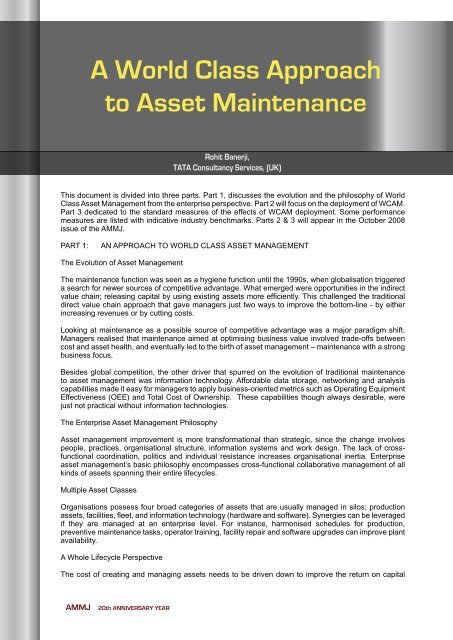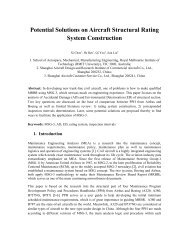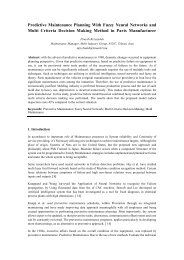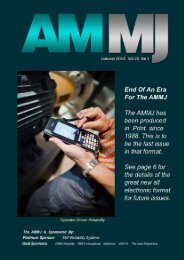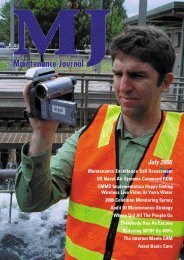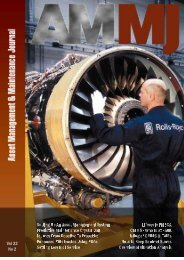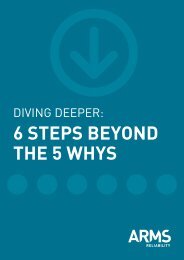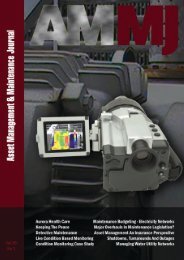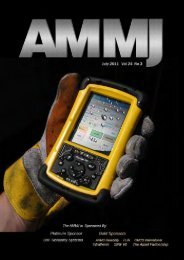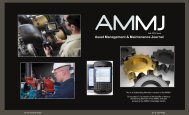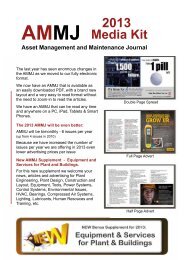DAY 1 - AMMJ
DAY 1 - AMMJ
DAY 1 - AMMJ
- No tags were found...
Create successful ePaper yourself
Turn your PDF publications into a flip-book with our unique Google optimized e-Paper software.
A World Class Approachto Asset MaintenanceRohit Banerji,TATA Consultancy Services, (UK)This document is divided into three parts. Part 1, discusses the evolution and the philosophy of WorldClass Asset Management from the enterprise perspective. Part 2 will focus on the deployment of WCAM.Part 3 dedicated to the standard measures of the effects of WCAM deployment. Some performancemeasures are listed with indicative industry benchmarks. Parts 2 & 3 will appear in the October 2008issue of the <strong>AMMJ</strong>.PART 1:AN APPROACH TO WORLD CLASS ASSET MANAGEMENTThe Evolution of Asset ManagementThe maintenance function was seen as a hygiene function until the 1990s, when globalisation triggereda search for newer sources of competitive advantage. What emerged were opportunities in the indirectvalue chain; releasing capital by using existing assets more efficiently. This challenged the traditionaldirect value chain approach that gave managers just two ways to improve the bottom-line - by eitherincreasing revenues or by cutting costs.Looking at maintenance as a possible source of competitive advantage was a major paradigm shift.Managers realised that maintenance aimed at optimising business value involved trade-offs betweencost and asset health, and eventually led to the birth of asset management – maintenance with a strongbusiness focus.Besides global competition, the other driver that spurred on the evolution of traditional maintenanceto asset management was information technology. Affordable data storage, networking and analysiscapabilities made it easy for managers to apply business-oriented metrics such as Operating EquipmentEffectiveness (OEE) and Total Cost of Ownership. These capabilities though always desirable, werejust not practical without information technologies.The Enterprise Asset Management PhilosophyAsset management improvement is more transformational than strategic, since the change involvespeople, practices, organisational structure, information systems and work design. The lack of crossfunctionalcoordination, politics and individual resistance increases organisational inertia. Enterpriseasset management’s basic philosophy encompasses cross-functional collaborative management of allkinds of assets spanning their entire lifecycles.Multiple Asset ClassesOrganisations possess four broad categories of assets that are usually managed in silos; productionassets, facilities, fleet, and information technology (hardware and software). Synergies can be leveragedif they are managed at an enterprise level. For instance, harmonised schedules for production,preventive maintenance tasks, operator training, facility repair and software upgrades can improve plantavailability.A Whole Lifecycle PerspectiveThe cost of creating and managing assets needs to be driven down to improve the return on capital<strong>AMMJ</strong>20th ANNIVERSARY YEAR


